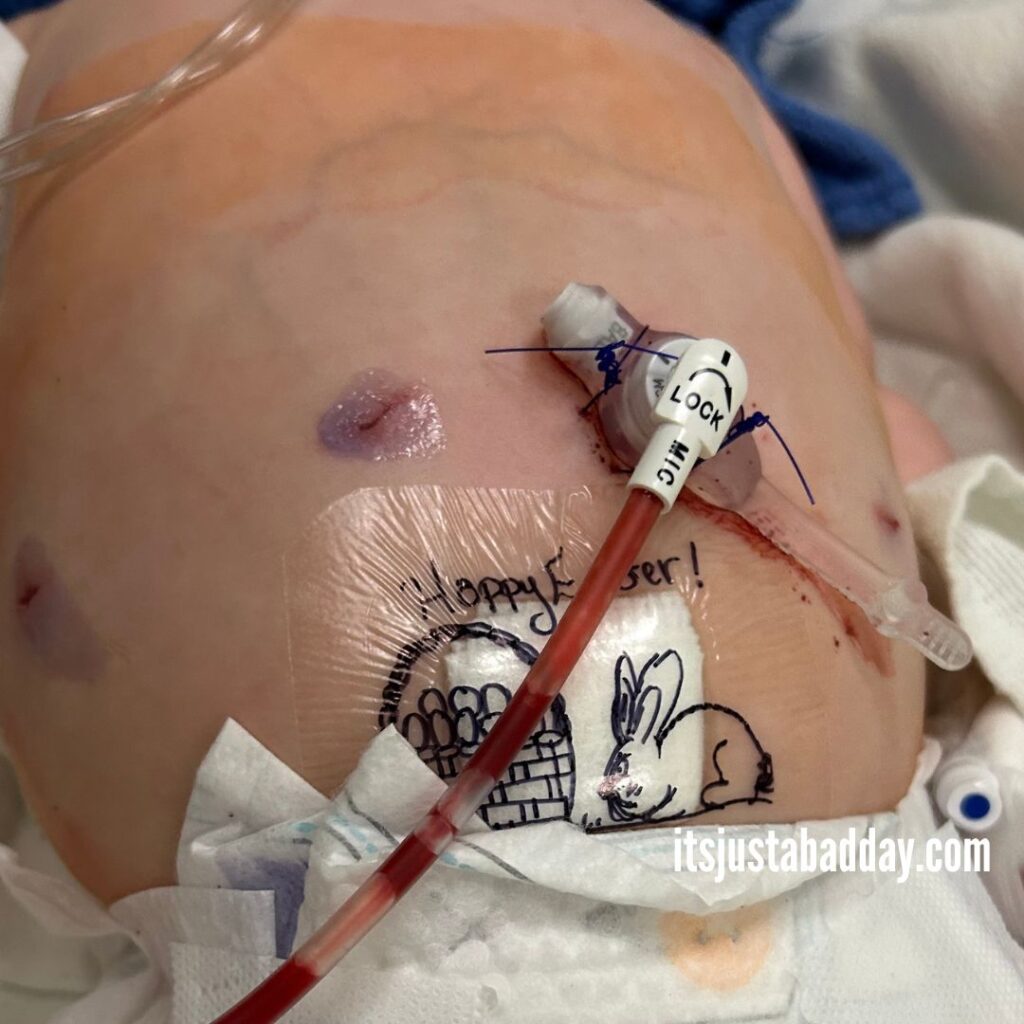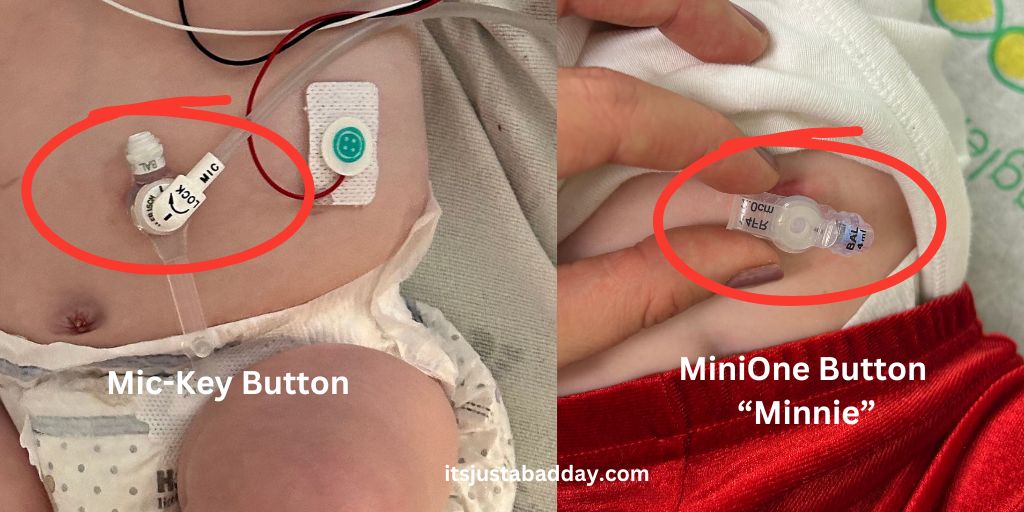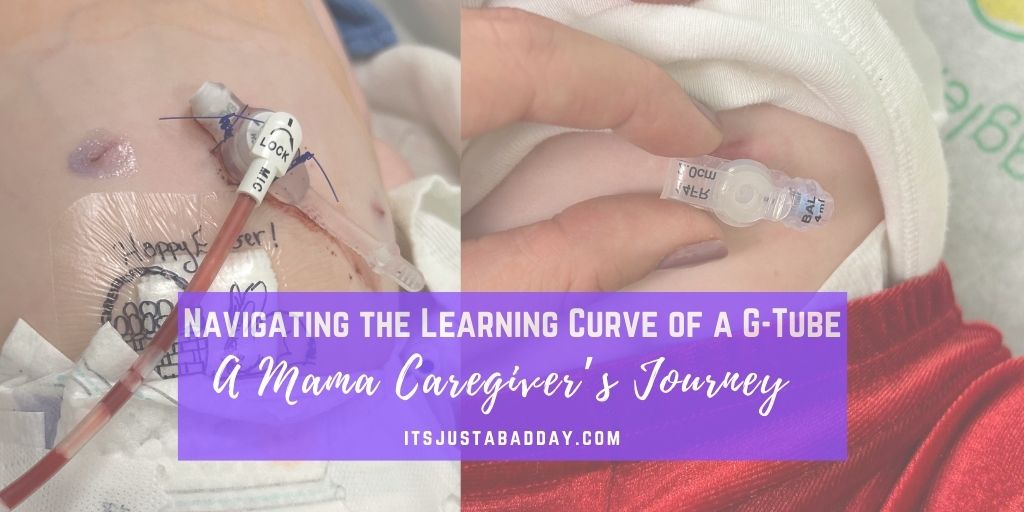When I became a mom to a baby with a G-tube, I had no idea what I was getting into. It was overwhelming, terrifying, and felt completely foreign.
If you had told me before Elle was born that I would be managing tube feeds, troubleshooting leaks, and making complex medical decisions for my baby, I’m not sure I would have believed you.
The Beginning: When Feeding Became a Struggle
When Elle was first born, I thought she was an efficient eater because she would eat for a few minutes and then quit. But about a week into her little life, I started noticing something wasn’t right.
She didn’t want to eat. My husband and I resorted to force-feeding her with a syringe, struggling for nearly an hour to get her to take 2 ounces of breast milk every 3-4 hours. I was freshly postpartum, trying to pump, juggling three other kids, and navigating a newborn who refused to eat—it was absolute chaos.
Then, everything changed when Elle stopped breathing and was rushed to the hospital. She spent two months on a ventilator, and feeding became the last thing on our minds. But when she finally started breathing on her own, she wanted nothing to do with putting anything in her mouth. We knew we had a long road ahead.
The G-Tube Decision: One of the Hardest Choices
Leaving the hospital with a G-tube wasn’t an easy decision. No parent wants to make the call to alter their baby’s body so that they can eat and take their meds.

But ultimately, we chose for Elle to get a G-tube and a Nissen fundoplication. The timeline for getting her to eat was unknown, and in order to heal from all of her lung and heart issues, she needed a reliable way to feed herself. As Elle grows, her lungs will grow, which will allow her to overcome many of her current obstacles.
The photo to the left is a picture immediately after her surgery. It was right before Easter and the surgeon decorated her bandage.
Beyond the surgery itself, I worried about what she would be fed through her tube. As someone with food allergies and strong opinions about nutrition, the thought of feeding her formula with questionable ingredients was tough to swallow. But we took it one step at a time and figured it out. We found options that worked for her (and us) and hit our stride.
The Learning Curve: Lessons, Mishaps, and Small Wins
If there’s one thing I’ve learned as a G-tube mama, it’s that you’re always learning. Here are just a few of the experiences that taught me along the way:
- Spilled stomach juices everywhere – I’ve had more G-tube extender mishaps than I can count. We’ve had stomach juices on bedsheets, my floor, clothes, pretty much everywhere. During the day, middle of the night. You name it. We’ve done it. (And I made a reel about it)
- Fed the bag instead of the baby – When Elle was vented 24/7, I forgot to unclip, and milk ended up in the Farrell bag instead of her stomach more times than I’d like to admit. EASY MISTAKE.
- Learning to be mobile – Initially, I didn’t want to go anywhere during a feed. But with three other kids, I had to learn to manage feeds on the go—starting with school pick-ups. I’d pack up Elle every time the bus came home to force myself to get comfortable. This really made me efficient at getting her pump set up and out the door quickly and helped build my confidence.
- Med port disasters – Sometimes, the med port pops open mid-feed, leaking stomach juices and meds everywhere. Other nights, I’ve woken up to soaked sheets from an overnight continuous feed gone wrong.
Finding Support & Game-Changing Resources
One of the biggest things that helped me navigate G-tube care was learning from other parents online. I searched #gtube and #gtubebaby and went down a rabbit hole of finding other mamas and daddies sharing their experiences. I even came across a TikTok video that showed a hack for priming the tube super fast before feedings—it changed the game for us! I was so grateful for that post, and I even showed Elle’s nurses, who then went on to teach others.
On top of that, the support from other G-tube parents has been incredible. A friend I met while studying abroad has a daughter with a G-tube, and she sent me a link to a little portable stand for Elle’s pump and tubing. Now that Elle is crawling, this stand has been a lifesaver!
I’m slowly trying to add to the support online too with posts like this one for feeding tube awareness week.
Adjusting as a Family: How We Made It Work
From the very start, my kids were curious about Elle’s G-tube. Instead of making it a mystery, I showed them how it worked and what we had to do. Now, seeing them so involved is really sweet—my kids even offer to help with her meds and feeds. My littlest (who’s three) actually loves helping with her medicine at night! Don’t worry—it’s always supervised.
One of the biggest pieces of advice I’d give to other parents juggling G-tube care with multiple kids is to include them in the process. The more they learn and see it as normal, the better it is for everyone. I really believe this experience is teaching my kids empathy and understanding for all people. They know Elle has struggles and differences, but instead of seeing that as a problem, they love her even more for it. They’re super protective of her, and it’s been beautiful to watch them grow into such caring siblings.
It’s funny because G-tube feeding has become so second nature to us now. When someone new visits and I casually mention, “Oh, Elle’s sleeping and eating,” they give me a confused look. But for us, it’s just normal life!

The Unexpected Challenges (and Triumphs)
Since first replacing the gtube 12 weeks post-surgery, we’ve been having constant issues with the balloon that keeps the button secure in place.
Elle started with the Mic-Key button and had no issues with her first one. But once we replaced it, the problems began. I’ve had to replace it every few weeks because the balloon gets a hole in it and then falls out.
In December, we switched to the MiniOne button to try something different. She had it for three months but still had two broken balloons. To be honest, I was extremely frustrated with the MiniOne extenders. They CONSTANTLY fell out of the button—especially while she was sleeping, which resulted in soaked bed sheets and missed feeds. I DO like the med port in the Minnies because they close extra snug and don’t just pop open like the Mic-keys.
One of the most stressful moments happened when Elle’s MiniOne button fell out during a nap. Two hours later, I found it, and I couldn’t get it back in through her stoma. We rushed to the emergency department, where it took two doctors, a nurse, and two pediatric surgeons to finally replace it. That day, we switched back to the Mic-Key button, which has worked better for us overall.
Another major transition has been Elle’s nutrition. Since her G-tube placement, she had been getting fortified breast milk. But recently, I ran out of breast milk, and we had to switch to formula.
Knowing nutrition choices were extremely important to me, the feeding clinic suggested we switch her over to Kate Farms.
We started with Kate Farms 1.2, but she struggled with the switch for a month and began throwing up every single feed. For a while, she was essentially living on Pedialyte. Now, we’ve switched to Kate Farms 1.0 Peptide, and we’re monitoring how she tolerates it.
Despite the struggles, we’ve learned how to adapt. We’ve adjusted, grown, and become more confident in handling Elle’s feeds and medical needs. What once felt impossible is now part of our daily rhythm.
To the New G-Tube Parents: You’ve Got This
If you’re new to this journey, I want you to know:
You will figure it out. You will make mistakes, spill stomach contents (probably multiple times), and feel completely overwhelmed—but you will also find your stride.
Lean on support from others, ask questions, and don’t be afraid to advocate for what feels right for your child. And most importantly, give yourself grace. You are doing an incredible job.
If you’re a G-tube parent, what’s one thing you wish you had known at the start of your journey? Let’s share and support each other in the comments. 💜
Wishing You A Pain Free Day!

